As the choices for digital music consumption expand and content providers continue to proliferate, as does high-resolution music availability, hardware makers have had to evolve in synchronicity. The net result has seen a maturing of streaming, clock and digital conversion technologies, with many brands offering multi-box solutions which have elevated the sonic outcome. A native of Greece, relatively new company Ideon Audio is rightfully earning a reputation for excellence via products which provide innovative proprietary technologies, comprehensive functionality and solid build. Importantly, of course, Ideon Audio’s products have also been widely hailed for their excellent sound quality. Here, I’m looking at the company’s entry point 3-box combo featuring eos Stream streamer/server, eos Time (a dedicated USB clock regenerator) and eos DAC digital-to-analogue converter.
Dawn, Sun and Moon
The first thing I noticed after the courier dropped (not literally, although that has happened before) the four boxes in my garage was the considerable weight for what were, after all, digital products. By the way, I mentioned four boxes, one small box contained the Ideon Audio ‘The Siren’, a classy-looking USB cable, immaculately built in-house, which serves as the interface between eos Time and eos DAC. It can, of course, be used as the USB cable of choice within any digital playback context with USB connectivity.
Within its box, each hand-made in Greece component is nestled within a pull-string cloth bag featuring an embroidery of Ideon Audio’s logo. The products are well built and, as mentioned above, are heavier than your average digital component, something that points to solid power supply design. Front panels are sparsely featured, with only eos DAC having a large display and rotary knob. The curved etch on eos Stream’s left hand side is matched to the DAC’s display but not matched on eos Time, something that would have provided consistency in terms of a styling motif from component to component. Call me a pedant.
So, let’s start with the DAC. The eos DAC features technology which has been trickled down from Ideon Audio’s spare-no-expense Absolute and Epsilon flagship components. As the company states, “we have declared war on linear and non-linear distortion and noise” and to that end, Ideon Audio has adopted a number of clever engineering strategies including some proprietary circuitry.
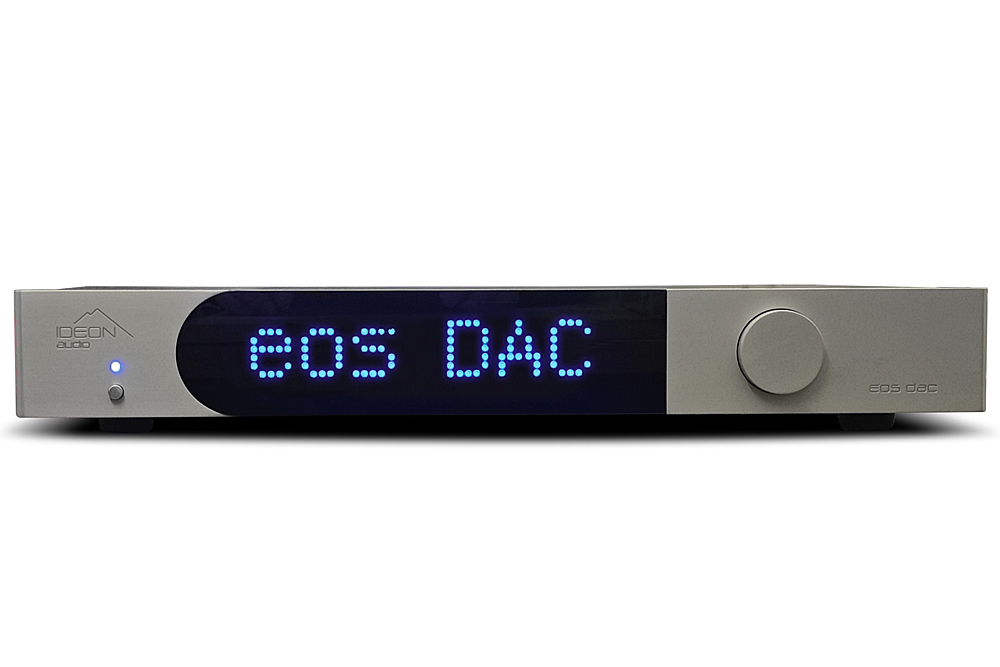
Firstly, the widely used USB input features a three-stage noise reduction circuit which Ideon Audio claims eliminates digital noise. The stout power supply employs select high-quality, low-tolerance-rated regulators and ultra-low ESR audio-grade capacitors, all elements selected for their low-noise characteristics.
The eos DAC features no less than three internal clocks derived from the flagship models. These femto clocks are top-of-the-line models featuring ultra-low jitter and ultra-low phase noise in what Ideon Audio states is a “no-compromise” architecture. Each of the three clocks is run via its own dedicated power supply.
An eight channel ‘HyperStream’ technology is married to an engineered in-house analogue output stage in a fully balanced circuit eschewing capacitors from the signal path while sporting its own dedicated power supply feed. The company claims the circuitry is a unique topology. As per Ideon Audio philosophy, the eos DAC is a modular design in order to provide the opportunity for future upgrades. Also of note is Ideon Audio’s cooperation with ESS Technologies in developing proprietary software for the DAC chip architecture in order to provide an upgradeable path via firmware.
Input and output socketry include the USB-B input as mentioned above, and two S/PDIF options via RCA and BNC coaxial. Analogue outputs provide both balanced XLR and unbalanced RCA connectivity. While stating it’s “input dependent” Ideon Audio suggests that via USB, eos DAC is capable of high-resolution PCM support from 44.1 kHz to 384 kHz in up to 32-bit while DSD is supported to 8x (or DSD512). In the company’s words on its website, capabilities include “Native support and playback for all DSD and PCM formats/frequency rates.”
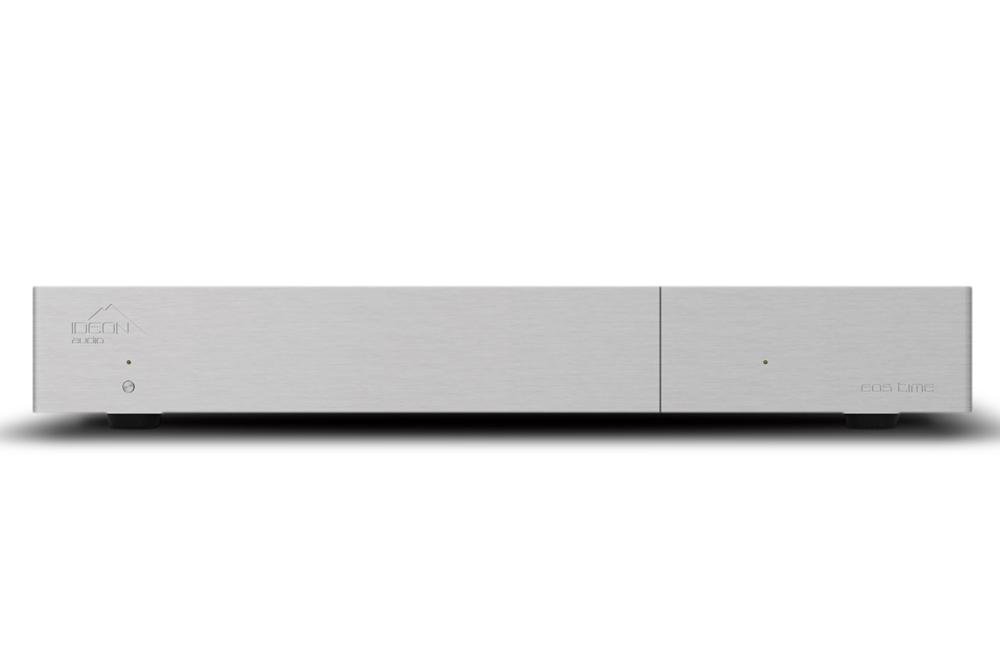
Now to eos Time. Ideon Audio refers to Time as a “state-of-the-art USB signal conditioning device”. Time is an improvement over Ideon Audio’s 3R Master Time, with a superior ultra-low jitter femto clock, a new PCB circuit design, a refined and more robust triple power supply and an enhanced bank of new ultra-low ESR capacitors. Ideon Audio claims eos Time to perform “re-clocking, re-energizing, and re-driving the USB digital signal with correction at both the input and output stages”. The eos Time is fully PCM and DSD compatible. While there are obvious synergies between Time and its eos stablemates, the suggestion is that eos Time can wring not-so-subtle performance and sonic improvements to any DAC system with the requisite connectivity.
Being a USB-based component, eos Time provides USB only input (USB-B) and output (USB-A). A small toggle switch controls on/off for the USB circuit’s 5V power supply rail. An IEC socket rounds out the super-sparse back panel. The unit weighs 10kg, a substantial mass for a clocking device.
Finally, eos Stream. With the eos Stream streamer/server/renderer, Ideon Audio has scaled down trickled technology from its state-of-the-art flagship Absolute Stream. These technologies have been developed in-house and are proprietary to Ideon Audio. The eos Stream can play via NAS drives and non-networked external storage devices (via USB-A ports) while also being capable of streaming from music content providers like Tidal, Qobuz, Spotify and more.
The eos Stream’s rear panel includes an RJ45 ethernet port, two USB-A storage device and two USB-A audio sockets. An IEC socket with fuse, plus spare, provides AC input. Again, quite a simple connectivity bay that gets the job done.
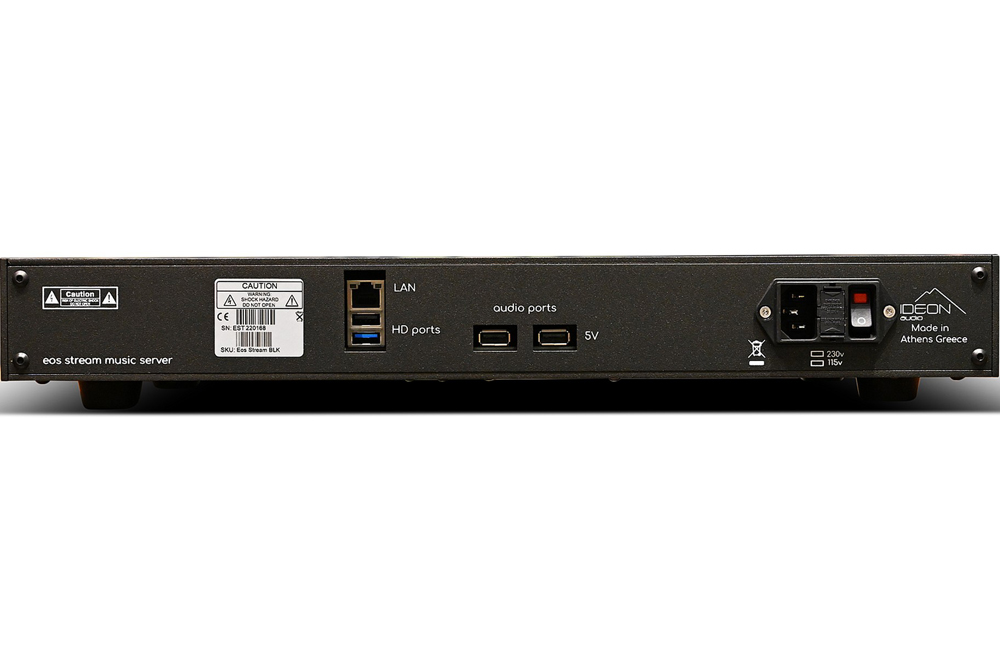
The eos Stream features an in-built low jitter femto clock, which can be future-upgradeable, while the CPU core (as Ideon Audio refers to it but it’s not to be confused with Roon Core) has been totally optimised for audio playback at its highest quality. As confirmation of that target, Ideon Audio states, “When we set out to design the eos Stream, we aimed at achieving dynamic, life-like natural sound to complement the eos DAC and offer a high level of musical satisfaction, rarely found in digital playback.”
Again, Ideon Audio has employed multiple over-engineered, discrete, low-noise linear power supplies in eos Stream. A proprietary, ultra-low ESR, bypass power filter was applied to provide improved “transient current quality”.
As mentioned above, I was sent Ideon Audio’s The Siren USB cable. The cable’s construction and connector quality seemed first-class. No issues here, and while I used it in the framework of the eos trio, I’d assume The Siren would make for a reliable and long-lasting interface within non-Ideon Audio digital contexts.
On Wings at Dawn
For playback, Ideon Audio has designed its own web-based software. It’s a tad primitive-looking but is functional, in a somewhat clunky way. It does provide a playback option which, despite its ergonomic limitations, performs well sonically.
As far as playback convenience, GUI, general artist/album information and overall software excellence there’s little to compare to Roon. On first setup after connecting in the context of my system, the eos components ‘talked’ to Roon without a stumble (minus my own fumbling) and I was playing from my library within minutes. Like it.
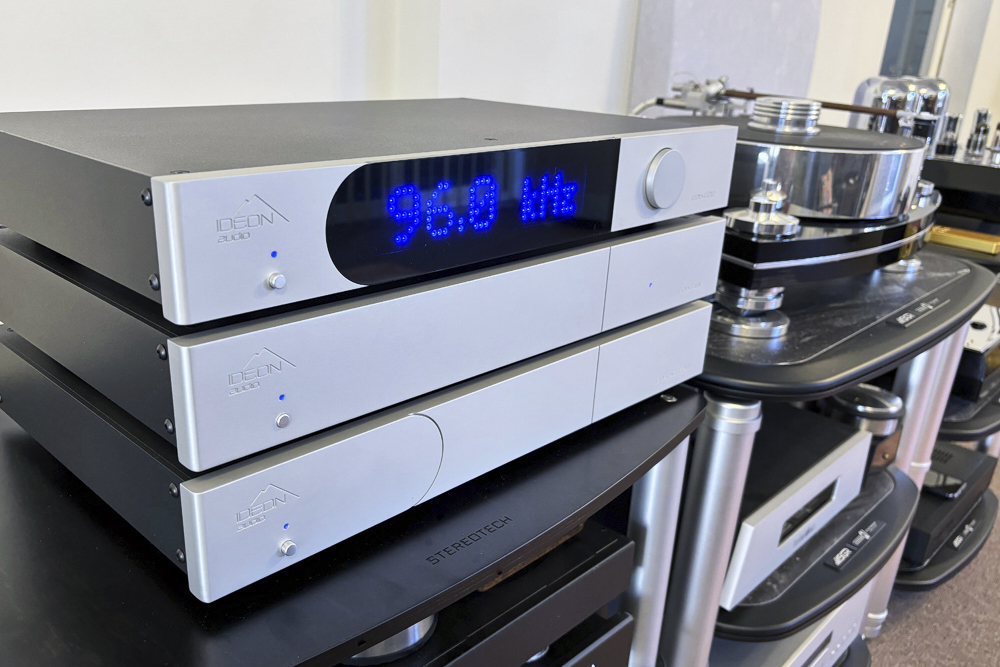
Well, the eos combo’s sense of fullness and pleasing subtle warmth through the midrange was a sonic trait I picked up from the get-go. It’s a big, generous sound, with plenty of natural detail and good dynamic expression. I continue to be surprised, and pleased, about how fluid and natural streaming has become. Whether playing from stored files, in whatever format and resolution, or whether I’m streaming from Qobuz and Tidal (back when I had the latter) the experience has become increasingly satisfying.
The three-box combo was capable of providing deep insights into the music. Play any well-produced recording of acoustic instruments and you’ll be struck by the true tonal qualities and level of nuance at hand. I often use a couple of albums from the Nicolas Parent Trio due to their excellent production quality and enjoyable music. On “Tori”, a select track from the trio’s album of the same name, Parent’s guitar played with stunning realism, meaning that as per the real instrument, there was a natural timbral faithfulness, a sharply quick transient leading edge to notes, and a truthful expression of dynamic shades. The same applied to the percussion accompaniment, which serves as an accent across most of the album’s tracks, and which were incisively and tightly rendered by the eos team as the conduit to my system.
Vocals rendition was also a strength. I’ve been getting into some of the tracks from American/Canadian singer-songwriter Lhasa de Sela’s album, simply titled Lhasa. On “Love Came Here”, the tautness of the driving snare actually underlined the singer’s superb vocal reproduction via the eos combo. There’s a rhythmic tightness to the band behind her, and de Sela’s somewhat delicate vocal rides above her bandmates with clarity, purpose and beauty.
Calexico’s Carried to Dust’s “Bend to The Road” saw the track’s dark ambience translate to my neurons in a way that took me deep into the song’s mood. There was terrific immediacy to Joey Burns’ almost whispered vocals while the guitar followed with exceptional credibility. Much like really, really good digital can be, the eos combo’s handling of high frequencies was slightly sweet yet startingly convincing. This was evident on the Latino-tinged “El Gatillo – Trigger Revisited” where the horns had appropriate incision, yet they never strayed into brightness.
Soundscapes were large across all perspectives. Jeff Goldblum’s “Come-on-a-My House” from The Capitol Studio Sessions album with The Mildred Snitzer Orchestra was wide, tall and deep. Imelda May handling vocals had her focused in steady imaging and the orchestra appropriately positioned with stage-rear dimensionality. The sense of fun and dedication to the music comes across via eos. Yes, I know that’s a more subjective observation, but that’s how I felt while listening to, not just this album, but most of the music I auditioned the eos with. To me, that is super-important.
That same dimensional richness I experienced via Goldblum’s live album – and many others I usually employ for my evaluations – was evident when playing orchestral works. Take the iconic audiophile recording of Copeland’s Fanfare for the Common Man from Reference Recordings with Eiji Oue conducting the Minnesota Orchestra. The album presented a spacious acoustic ambience stretching wider than the speaker positions, taller than the tweeters’ height and deeper than the speakers’ plane. Plus, it slammed the timpani, with Wilson Audio Alexia V’s woofers blasting powerfully and, enjoyably, shaking my skeletal framework.
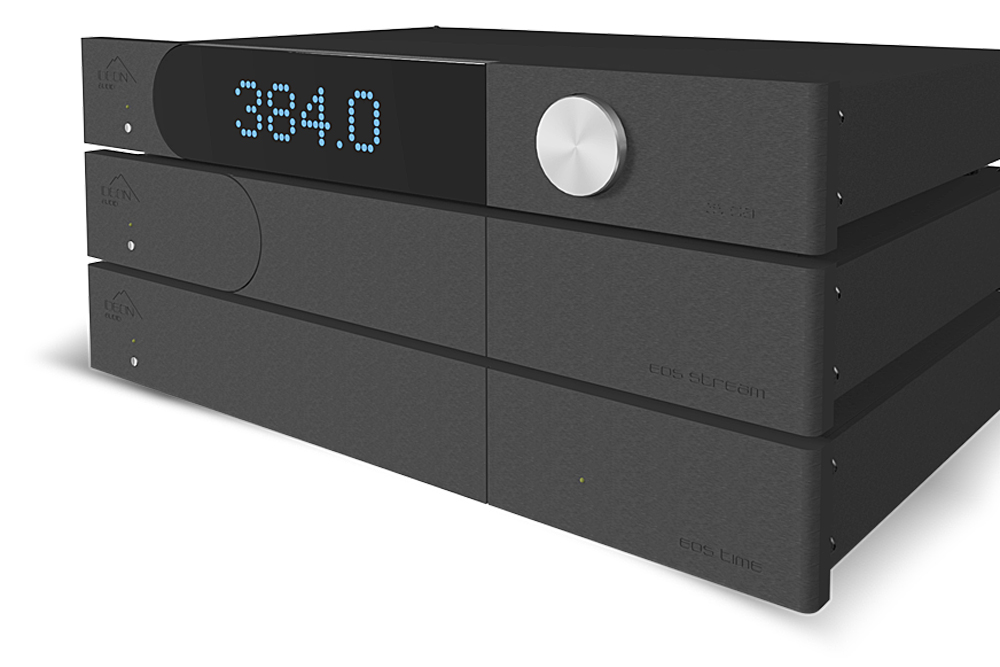
Hard-driving music slammed with gusto too. The eos trio is not shy to Rock ’n’ Roll baby! With some streamers, some of my favourite cuts are sometimes diminished in terms of power and dynamic expression, especially those streamers aiming at providing a somewhat more ‘analogue’ sonic signature. Not here. While all that tonal texture, refined detail and smooth resolution analogue lovers treasure – and use as an attack point against digital playback – was firmly maintained. The eos combo played hard with Sasquatch, Metallica, Audio Slave, Tool, At The Drive-In, Vast and so, so much more.
Conclusion
It’s interesting that the eos three-box combo is actually the entry-point product into Ideon Audio’s digital playback portfolio. In Aussie money, it’s a near $45K digital playback system from a relatively new company. Having said that, there are many one-box converters, minus the streamer and clock regenerator, which are priced at round about the same dosh (my own reference Totaldac tri-unity converter included). So yes, you could spend a whole lot less, but you could also spend a whole lot more; the return on investment is purely your call to make.
What Ideon Audio’s eos products offer is a highly-tuned circuit design featuring proprietary technologies, superbly engineered power supplies and very good general build quality. The big one is the performance. I can’t think of any audiophile and music lover left wanting with this combo. It performs extraordinarily well, functions completely trouble-free (at least during its tenure in-house) and inspires confidence in terms of its overall design.
Yes, the eos trio, along with other exceptional current digital playback systems, are super-refined and have narrowed the gap between streaming (especially stored files) and the best legacy music playback formats, no matter whether acrylic or vinyl. That indeed, is a strong signal that digital playback has, most assuredly, entered a new dawn…
… Edgar Kramer
This email address is being protected from spambots. You need JavaScript enabled to view it.
Associated Equipment
- Speakers — Wilson Audio Alexia V, Axis Loudspeakers VoiceBox S (nearfield monitor), Vermouth Audio Little Luccas Mk.II, Atacama stands
- Amplifier — Gryphon Audio Antileon EVO
- Preamplifier — Supratek Cortese, Totaldac d1-triunity (direct to amplifier)
- Sources — Digital:432 EVO Aeon Mk.3 Reference Music Server/Roon Core, Yamaha CD-S2100 transport, Totaldac d1-triunity DAC. Analogue: Transrotor Crescendo with Konstant Studio controller, Reed 1X Tonearm with upgraded internal wiring, Shelter Harmony cartridge, The Funk Firm Houdini cartridge decoupler, Supratek Cortese & REDGUM Audio RGPH2 phono stages
- Processor — DEQX PreMate (part of arsenal/casual use)
- Cables — VYDA Laboratories Orion Silver Reference HFC IC and speaker cables, PSC Audio custom design XLR, Vermouth Audio Reference loom,ZenSati Zorro, Tubulus Concentus USB
- Audio Rack — SGR Audio Statement Model V, Aspire Audio Belgravia amplifier platform (customised for Gryphon Audio Antileon EVO), Stereotech Aluminar Dark 3-tier rack
- Acoustic Treatment — Vicoustic Multifuser Wood, Wavewood Ultra, Cinema Round Premium and Super Bass Extreme
- Miscellaneous — Silent Angel Bonn N8 Pro network switch, GigaWatt PF-1 EVO power strip, Les Davis Audio Viscoelastic CLD discs, VRC Vinyl Record Cleaning systemplus miscellaneous accessories
Ideon Audio eos DAC, eos Stream, eos Time
Price: eos DAC AU$15,950 (Black AU$16,350), eos Time AU$10,290 (Black AU$10,690), eos Stream AU$16,390 (Black AU$16,790), 1m The Siren USB cable AU$2850
Warranty: 24 Months
Australian Distributor: Absolute Hi End
+61 488 777 999
www.absolutehiend.com
Ideon Audio
Parren 6, Neo Psychiko11525
Athens
Greece
+30 210 6199887
www.ideonaudio.com
